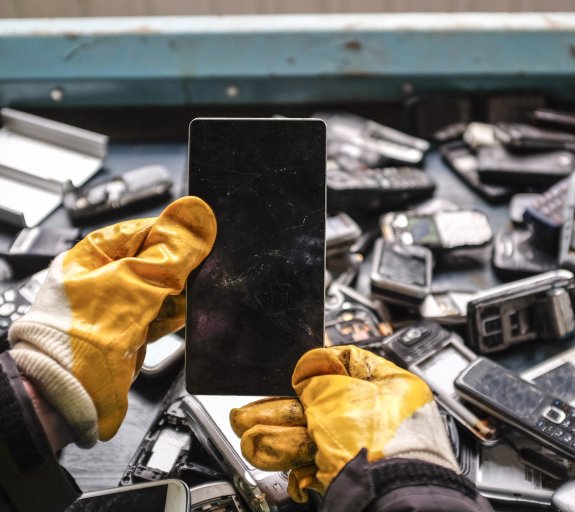
Breaking the cycle on International E-Waste Day
- 14 October 2022 (5 min read)
Key points:
- E-waste is the fastest growing stream in the world – 53 million tonnes are produced each year1
- Recycling discarded and obsolete electronic devices could avoid depletion of the earth’s elements
- Investors can help by allocating capital to firms championing recycling and repair
We live in an increasingly disposable society. Consumers have become used to fast fashion, fast food, all available at the click of a button, 24 hours a day. This phenomenon is also valid for smartphones. Every year, a new iPhone is launched, and many people are queuing to buy a new one while their old device is still working. While this can of course be a promising source of cross-sector growth, it’s important to consider the ethics of a throwaway consumer mindset and consider the cost of the rising damage and resource loss should this remain unchecked. But what can we, as consumers and investors, do to help?
E-Waste: A growing modern phenomenon
Discovering and buying exciting new electronics such as smartphone or laptop is expected, for the most part, to be a positive experience. Most of these products all come with upgraded capabilities such as longer lasting batteries, improved touchscreens, better screen resolutions and all with reduced weight and size. However, over 50 elements are increasingly critical to reach these technology feats including lithium, cobalt, and other rare earth elements. This poses several issues. Firstly, the increase in demand for such technology devices means that there is a need to increase the supply of these elements while their capacity is limited. Secondly, there is a real geographical and political risk due to the concentration of minerals in few geographical areas such as China and many countries in Africa. Thirdly, mining these elements has an impact on the environment and poses issues for labour and human rights. More importantly, e-waste – generated by discarded electrical and electronic devices such as mobile phones, computers, headphones and other devices – is growing at a fast pace. Each year, 53 million tonnes of e-waste is produced (an equivalent of 140 Empire State Buildings) while only 20% is recycled globally.2 The majority end up in landfill or are incinerated causing pollution, human health hazards and the loss of valuable finite resources.
Currently, 74% of people in Britain admit to throwing electronic devices (including mobile phones, laptops, TVs, computers and peripheries away, into bins destined for landfill.3 The WEEE Forum - the world's largest centre of competence for the management of waste electrical and electronic equipment – aims to tackle this via its annual ‘International E-Waste Day’.4
Recycle it all!
The focus of 2022’s International E-Waste Day centres around consumer electronics. The UN estimates that over 22 million tonnes of small e-waste were produced in 2019, representing 40% of the total global e-waste. At the current growth rate of 3% per annum, it will reach 29 million tonnes by 2030.5 Hence, it is important that people are aware and can act at an individual level by avoiding changing their devices when it is still working, initially trying to repair them and discarding these small items appropriately.
Additionally, the urgency of addressing this massive source of waste and pollution has been raised by sustainability activist organisations such as Right to Repair6 . The group is campaigning for governments to propose and enforce regulation which prevent continuous e-waste generation. This includes initiatives such as compelling manufacturers to design products which are easy to disassemble, enabling the replacement of key components or making the repair cost lower than the price of a new devices. As such, as a consumer it is key to encourage companies to change their practices by favouring products of those that have sustainable practices, to avoid generating unnecessary e-waste.
Consumers are not the only ones who need to act. Many corporations also have a massive role to play in the battle against e-waste. The Financial Times recently reported that millions of data-storing devices such as servers (which are replaced or upgraded every three or five years) are shredded by mainstream tech companies, banks or police services each year).7 A key barrier to recycling is the security of sensitive data and fears over data leaks and regulatory repercussions. This is despite the ability of some companies such as Techbuyer who can wipe the data on-site before the devices leave the premises, and then sell the server to customers that can make use of them for more years. The practice of shredding instead of re-using is harmful for both the bottom line of these businesses, but also for the environment.
How can we help to cut down on e-waste?
While it is still early to see regulation support on e-waste, investors can allocate their capital to companies that are recycling precious metal in a sustainable way. While a majority of these companies are still in the private space, some are already investable for listed equity investors. Examples of companies in this area include Li-Cycle, a Canadian company dedicated to recovering materials from lithium-ion batteries and reintroducing them into the supply chain. Preserving this one component of e-waste alone can have a significant impact upon the environment. It is estimated that the total number of global electric vehicles (EVs) will reach 600 million units by 2040 and c. 10 million EVs on the road today should reach their end-of-life stage by 2040.8 This means that a more efficient and sustainable process to recover “waste” generated by batteries is urgently needed. Li-Cycle has developed a highly efficient battery recovery process, able to recover up to 95% of all constituent materials, without producing any landfill waste. The company sells these critical raw materials to stakeholders in the battery supply chain including lithium, cobalt and nickel. As more automotive companies seek to manufacture electronic or hybrid vehicles, Li-Cycle is well placed to benefit from its battery recycling operation against a backdrop of increased demand and ongoing supply chain disruption.9
As Rich Kenney, the Sustainability and Research Director of Techbuyer, says: “It starts with an understanding of the cost of decisions you make, whether that’s consumption or data. But small decisions on an individual level can have a macro-effect for our entire planet.”
For more information on International E-Waste Day, visit https://weee-forum.org/iewd-about/
Companies shown are for illustrative purposes only as of 11/10/2022. It does not constitute investment research or financial analysis relating to transactions in financial instruments, nor does it constitute an offer to buy or sell any investments, products or services, and should not be considered as solicitation or investment, legal or tax advice, a recommendation for an investment strategy or a personalised recommendation to buy or sell securities.
- U291cmNlOiBHbG9iYWwgRS13YXN0ZSBNb25pdG9yIDIwMjAgKGl0dS5pbnQp
- U291cmNlOiBCYW5rIG9mIEFtZXJpY2EgTWVyaWxsIEx5bmNoLCBNYXJjaCAyMDE4
- U291cmNlOiBCcmlnaHQgRnV0dXJlcyAodGVjaGJ1eWVyLmNvbSk=
- U291cmNlOiBJbnRlcm5hdGlvbmFsIEUtV2FzdGUgRGF5IHwgV0VFRSBGb3J1bSAod2VlZS1mb3J1bS5vcmcp
- U291cmNlOiBJbnRlcm5hdGlvbmFsIEUtV2FzdGUgRGF5IHwgV0VFRSBGb3J1bSAod2VlZS1mb3J1bS5vcmcp
- U291cmNlOiBOZXcgRVUgcnVsZXMgb24gc21hcnRwaG9uZXMgYW5kIHRhYmxldHM6IGhhdmUgeW91ciBzYXkhIC0gUmlnaHQgdG8gUmVwYWlyIEV1cm9wZQ==
- U291cmNlOiBXaHkgQmlnIFRlY2ggc2hyZWRzIG1pbGxpb25zIG9mIHN0b3JhZ2UgZGV2aWNlcyBpdCBjb3VsZCByZXVzZSB8IEZpbmFuY2lhbCBUaW1lcyAoZnQuY29tKSBpdCBjb3VsZCByZXVzZSB8IEZpbmFuY2lhbCBUaW1lcyA=
- U291cmNlOiBCZXJuc3RlaW4sIDMxc3QgQXVndXN0IDIwMjEsIEVsZWN0cmljIHJldm9sdXRpb24g
- U291cmNlOiBMaS1DeWNsZTogQWNoaWV2ZSBFViBCYXR0ZXJ5IFJlY3ljbGluZyBMZWFkZXJzaGlwIGRlc3BpdGUgaGljY3VwcyAoTllTRTpMSUNZKSB8IFNlZWtpbmcgQWxwaGE=

ACT range
Invest with purpose to support the transition to a more sustainable economy.
Learn moreDisclaimer
This document is for informational purposes only and does not constitute investment research or financial analysis relating to transactions in financial instruments as per MIF Directive (2014/65/EU), nor does it constitute on the part of AXA Investment Managers or its affiliated companies an offer to buy or sell any investments, products or services, and should not be considered as solicitation or investment, legal or tax advice, a recommendation for an investment strategy or a personalized recommendation to buy or sell securities.
Due to its simplification, this document is partial and opinions, estimates and forecasts herein are subjective and subject to change without notice. There is no guarantee forecasts made will come to pass. Data, figures, declarations, analysis, predictions and other information in this document is provided based on our state of knowledge at the time of creation of this document. Whilst every care is taken, no representation or warranty (including liability towards third parties), express or implied, is made as to the accuracy, reliability or completeness of the information contained herein. Reliance upon information in this material is at the sole discretion of the recipient. This material does not contain sufficient information to support an investment decision.
Issued in the U.K. by AXA Investment Managers UK Limited, which is authorised and regulated by the Financial Conduct Authority in the U.K. Registered in England and Wales, No: 01431068. Registered Office: 22 Bishopsgate, London, EC2N 4BQ
In other jurisdictions, this document is issued by AXA Investment Managers SA’s affiliates in those countries.
Risk Warning
The value of investments, and the income from them, can fall as well as rise and investors may not get back the amount originally invested.